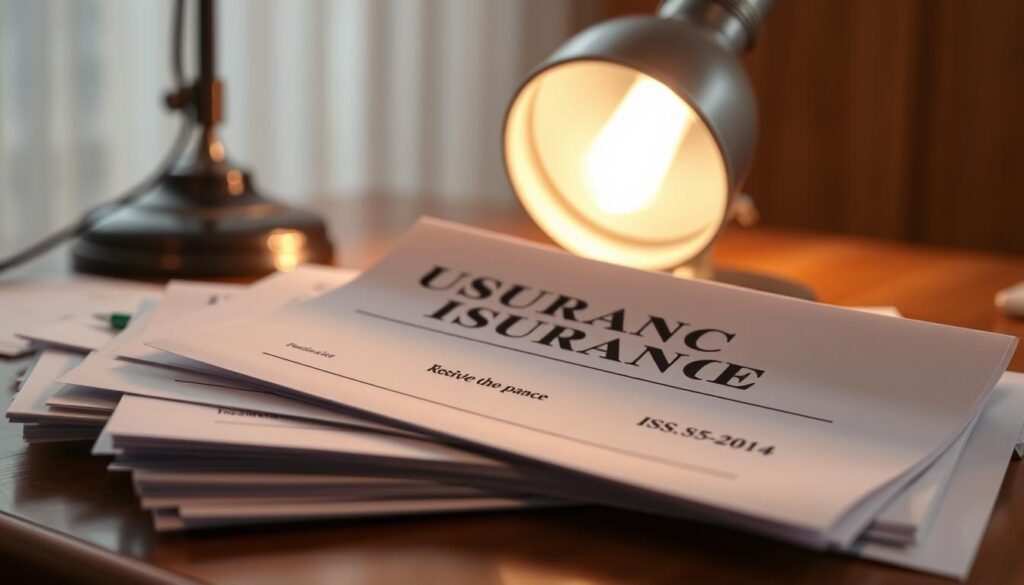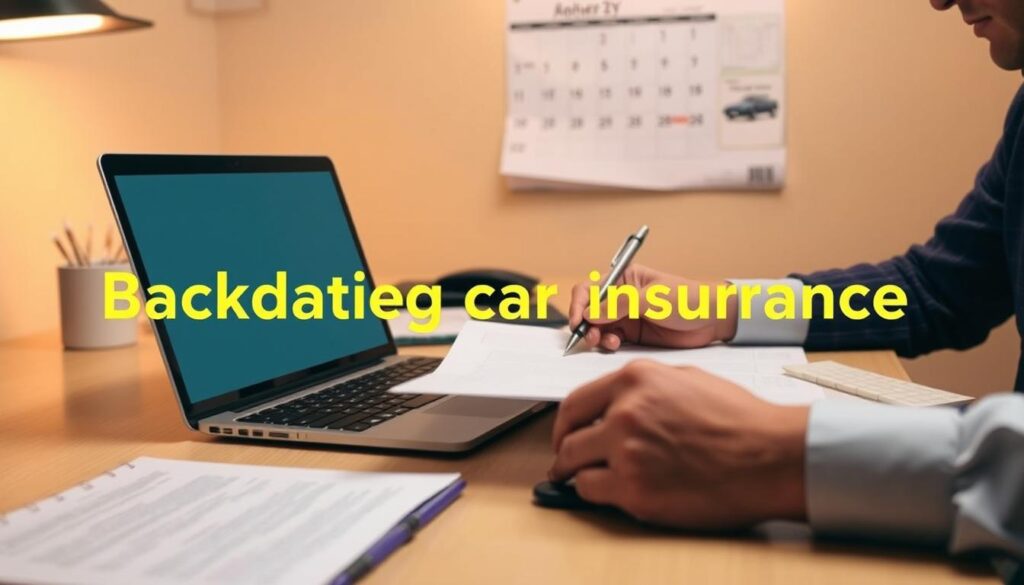Imagine you’ve just bought a new car but forgot to update your auto insurance policy. Or, maybe you were in an accident and found out your policy had expired. In these cases, retroactive coverage can really help.
Backdated auto insurance, or retroactive coverage, protects you for times that have already passed. It’s very useful when you need to claim for something that happened before your policy started.
Knowing how backdated auto insurance works can help you choose the right coverage. In this article, we’ll dive into the details of retroactive coverage and how it can benefit you.
Key Takeaways
- Backdated auto insurance provides coverage for past incidents.
- Retroactive coverage is key when you forget to update your policy.
- It’s important to understand the terms and conditions of backdated auto insurance.
- Retroactive coverage can prevent financial losses from past incidents.
- Talking to your insurance provider about your options is essential.
What Is Backdated Auto Insurance and How Does It Work?
Backdated auto insurance is key for drivers facing unexpected situations. It’s a special insurance that covers you even before you bought it. This is for times when you weren’t insured but should have been.
Definition and Basic Principles
Backdated auto insurance, or retroactive coverage, helps drivers who missed insurance. It’s for those who had a gap in their coverage. This insurance aims to protect you from past accidents or damages when you were uninsured.
The Mechanics of Retroactive Coverage
To get backdated auto insurance, you need to talk to an insurance company. They’ll look at why you weren’t insured and your driving history. If they say yes, they’ll go back in time to cover you from the start date you want.
Common Misconceptions About Backdating Policies
Many think backdating is the same as insurance fraud. But, it’s okay if done right and with the insurer’s okay. Also, not every insurance company offers backdating. So, it’s not a standard service.
| Key Aspects | Description |
|---|---|
| Retroactive Coverage | Provides financial protection for past events |
| Eligibility | Depends on the reason for the lapse and driving history |
| Insurer Policies | Vary by company; not all offer backdating |
Legitimate Reasons to Seek Backdated Car Insurance
Drivers might need to backdate their car insurance for several good reasons. Knowing these reasons can help them deal with tricky situations. It also helps them make smart choices about their insurance.
Unintentional Coverage Lapses
One common reason is an unintentional lapse in coverage. This can happen if someone forgets, can’t afford it, or makes a mistake. Backdating can fix this, giving them the protection they need.
New Vehicle Purchase Scenarios
Buying a new car often requires backdating insurance. This is because drivers need insurance before they can drive their new vehicle off the lot. It’s a must for those buying at dealerships.
Policy Transfer Between Companies
Switching insurance companies can lead to a gap in coverage. Backdating can fill this gap, keeping drivers protected. It’s important to know what documents and timing are needed for these transfers.
Documentation Requirements
To backdate a policy, drivers need certain documents. These include proof of previous coverage, vehicle registration, and ID. Having these documents ready can make the process easier.
Timing Considerations
The timing of a backdating request is key. Insurance companies have rules about backdating. Waiting too long can lead to denied requests or more problems.

Understanding why drivers might need to backdate their insurance is important. It helps them handle insurance issues well. This way, they can make sure they’re well-protected.
Insurance Companies That Will Backdate Car Insurance
Not all insurance companies are the same when it comes to backdating car insurance. Some big providers offer more flexible options than others. The decision to backdate a policy depends on state laws, the type of coverage, and why you need it backdated.
Major National Providers With Backdating Options
Big names in insurance offer backdating options. Each has its own rules about backdating. Some are more open to it than others.
- State Farm: Offers backdating in certain circumstances, requiring documentation to support the request.
- Geico: Allows backdating for specific situations, with a maximum backdating period that varies by state.
- Progressive: Provides backdating options, mainly for new policies, with a detailed application process.
Regional Insurers With Retroactive Coverage
Regional insurers might be more flexible than big national companies. Some regional insurers that offer retroactive coverage include:
- Amica Mutual: Known for customer service, Amica offers backdating in certain cases.
- Erie Insurance: Provides backdating options, mainly for customers switching from another carrier.
- Auto-Owners Insurance: Offers retroactive coverage in specific situations, with a focus on detailed documentation.
Company-Specific Policies and Limitations
Each insurance company has its own rules for backdating. Knowing these rules is key for a successful backdating request.
Maximum Backdating Periods by Provider
| Insurance Provider | Maximum Backdating Period |
|---|---|
| State Farm | Up to 30 days |
| Geico | Varies by state, typically up to 6 months |
| Progressive | Usually up to 60 days |
Required Proof and Documentation
To backdate a car insurance policy, you’ll need to provide certain documents. This includes:
- Proof of previous insurance coverage
- Vehicle purchase documents
- Police reports or other relevant records
It’s important to talk directly to your insurance provider. They can tell you exactly what you need for backdating car insurance.
Step-by-Step Process: How to Backdate Car Insurance
Backdating car insurance can seem tricky, but knowing the steps helps. To backdate your car insurance, you need to talk to your insurance company, prepare documents, and go through a verification process.
Initial Contact With Your Insurance Provider
Start by reaching out to your insurance provider. This first step is key. Be ready to explain why you want to backdate and share basic policy details.
Essential Documentation to Prepare
You’ll need certain documents to backdate your insurance. These include your current policy, ID, and any supporting documents. Having these ready makes the process easier.
Verification and Approval Process
After you submit your request and documents, your provider will review them. They’ll check your application, verify the info, and look at the risk of backdating your policy.
Common Reasons for Denial
Insurance companies might deny backdating for a few reasons. These include:
- Providing false information
- Lack of sufficient documentation
- Exceeding the allowed time frame for backdating
Appeal Options if Rejected
If your backdating request is denied, you can appeal. This usually means providing more info or clearing up any misunderstandings.
| Step | Description | Key Considerations |
|---|---|---|
| 1. Initial Contact | Reach out to your insurance provider | Be prepared to explain your situation |
| 2. Documentation | Gather necessary documents | Ensure all documents are accurate and complete |
| 3. Verification and Approval | Wait for the insurance company to review your application | Be prepared to provide additional information if needed |

Backdated Auto Insurance: Legal Boundaries and Restrictions
Backdating auto insurance has legal limits and varies by state in the U.S. It helps drivers who forgot to renew their coverage. But, knowing the laws is key.
State-by-State Regulatory Differences
State laws play a big role in backdated auto insurance. Some states are more open to it, while others are stricter.
- Permissive States: Some states let insurance companies backdate policies easily, if conditions are met.
- Restrictive States: Other states have strict rules on backdating, with limited time frames or situations.

Time Limitations for Backdating Coverage
Insurance companies set limits on how far back a policy can be dated. Knowing these limits is important for drivers looking for retroactive coverage.
| Insurance Provider | Maximum Backdating Period |
|---|---|
| Provider A | 30 days |
| Provider B | 60 days |
| Provider C | 90 days |
Claim Restrictions During Backdated Periods
Pre-Existing Damage Exclusions
Insurance companies usually don’t cover damages from before the policy started, even if it’s backdated.
Fraud Prevention Measures
To stop fraud, insurers check backdated policies closely. They might ask for extra proof or checks.
Drivers should know these rules to make smart choices about backdated auto insurance. This ensures they follow state laws and insurance rules.
Financial Implications of Backdated Car Insurance Policies
Knowing the financial effects of backdating your car insurance is key. Backdating can lead to several financial issues that you should know about before you decide.

Premium Calculation Methods for Retroactive Coverage
When you backdate your car insurance, the premium is based on what you know at the time. This includes your car’s details, driving history, and more. Insurers use special formulas to figure out the premium, considering the backdated period and any claims.
Insurers look at your driving history during the backdated period when setting premiums. This can make premiums higher if you’ve had accidents or tickets.
Additional Fees and Administrative Charges
There are extra fees for backdating your car insurance. These include costs for handling the backdated policy and checking your information.
“The administrative costs associated with backdating a policy can be significant, and insurers may pass these on to the policyholder.” – Insurance Industry Expert
Cost Comparison With Standard and High-Risk Policies
Backdated policies are often pricier than regular ones because of the added risk. Yet, they might be cheaper than high-risk policies, depending on your situation and the insurer’s view of your risk.
Potential Long-Term Financial Impact
The long-term cost of backdating your car insurance can change a lot. It depends on the insurer’s pricing and your claims history. It’s important to understand the long-term costs of your policy.
Policyholders should think about their finances and insurance needs before backdating their policy.
Alternatives When You Can’t Backdate Auto Insurance
When backdating auto insurance isn’t an option, there are other ways to get coverage. You can look into temporary or short-term insurance, non-owner policies, or high-risk insurance markets.
Temporary and Short-Term Insurance Options
Temporary or short-term auto insurance is a good choice when backdating isn’t possible. These policies cover you for a short time, from a few days to months. They’re great for those who need coverage right away, like after buying a car or when their policy ends.
Key benefits of temporary insurance include:
- Flexibility in coverage duration
- Quick activation
- Potential cost savings for short-term needs
Non-Owner Policies as Stopgap Solutions
Non-owner auto insurance is a stopgap when backdating isn’t an option. It offers liability coverage for drivers without a vehicle. It’s perfect for those who rent cars often or borrow vehicles from others.
High-Risk Insurance Markets
For those who can’t get standard insurance, high-risk markets offer alternatives. These markets help drivers who are considered high-risk due to past driving issues or claims history.
State-Sponsored Insurance Programs
Some states have insurance programs for high-risk drivers. These programs help those who can’t get coverage from regular insurers.
Insurance Pools for Difficult Cases
Insurance pools, like assigned risk plans, are another option. They spread out high-risk drivers among insurers. This ensures everyone gets some coverage.
Exploring these alternatives can help you find insurance even when backdating isn’t possible. It’s important to choose the best option for your needs.
Avoiding Insurance Fraud: Legal vs. Illegal Backdating Practices
It’s important to know the difference between legal and illegal backdating in insurance. Backdating can be okay if done right and with the insurer’s okay. But, it can be fraud if not done correctly.
Where Legitimate Backdating Ends and Fraud Begins
Legitimate backdating is when someone asks to start their policy earlier. This is to cover something that happened before they bought the policy. It’s legal if the insurer agrees and the information is correct.
Fraudulent backdating is when someone lies about the policy start date. They might do this to cover a claim before the policy or to pay less for premiums.
Consequences of Fraudulent Backdating
Fraudulent backdating can have serious consequences. If caught, the policy can be canceled, claims denied, and legal action taken. Insurance companies take fraud very seriously.
How Insurance Companies Detect Improper Backdating
Insurance companies have ways to spot fraud, like digital systems and databases. These tools help find any wrong information given by policyholders.
Digital Verification Systems
Digital systems let insurers check policyholder info against their databases. They can look at driving history, claims, and more.
Cross-Reference Databases
Databases help insurers check info from different places. This way, they can spot any fraud or wrong information.
Knowing the difference between legal and illegal backdating helps avoid fraud. Policyholders can make sure their requests are done right and ethically.
Conclusion: Navigating Backdated Coverage Responsibly
Understanding backdated auto insurance coverage is key. It offers a safety net in certain situations, like when coverage lapses or when you buy a new car.
Big insurance companies and smaller ones offer backdating. But, it’s important to know their rules and limits. To get backdated coverage, you need to contact your insurance, prepare documents, and get approval.
Knowing the legal limits and restrictions is important. This includes knowing the rules in each state and the time limits. Also, understand how it affects your money, like how premiums are set and extra fees.
Being informed helps you use backdated coverage wisely. Always look at your insurance options carefully. If needed, get advice from a professional to make the right choice for you.
FAQ
What is backdated auto insurance?
Backdated auto insurance is coverage that starts from a past date. It protects you before you bought the policy.
Can I backdate my car insurance?
Yes, some companies let you backdate your insurance. But, it depends on the company and your situation. You should ask your insurance company about their policies.
What insurance companies will backdate car insurance?
Many big and small insurance companies offer backdating. But, each company has its own rules. It’s best to check with them directly.
How far back can I backdate my car insurance?
How far back you can go varies by company. Some might let you go back a few days or months. Others might have stricter rules.
What documentation is required to backdate car insurance?
You’ll need proof you’re eligible for insurance. You might also need to explain why you’re backdating, like a new car or a mistake.
Can backdated auto insurance be used for a claim that occurred before the policy start date?
Usually, backdated insurance can cover claims from the past. But, it depends on the company and your situation.
Are there any additional fees associated with backdating car insurance?
Yes, some companies might charge extra for backdating. These fees can differ based on the company.
Can I backdate car insurance if I’ve already had an accident?
Generally, companies won’t backdate if you’ve had an accident. Backdating is for specific, valid reasons.
How do I appeal a denied backdating request?
If your request is denied, you can appeal. You’ll need to provide more information or clarify your situation. Contact your insurance company to learn how to appeal.
Is backdating car insurance considered insurance fraud?
No, backdating for the right reasons isn’t fraud. But, trying to backdate for a fake reason is illegal.
Can auto insurance be backdated to cover a previously uninsured vehicle?
Sometimes, yes. Insurance can be backdated for an uninsured vehicle. But, it depends on the company and your situation.

